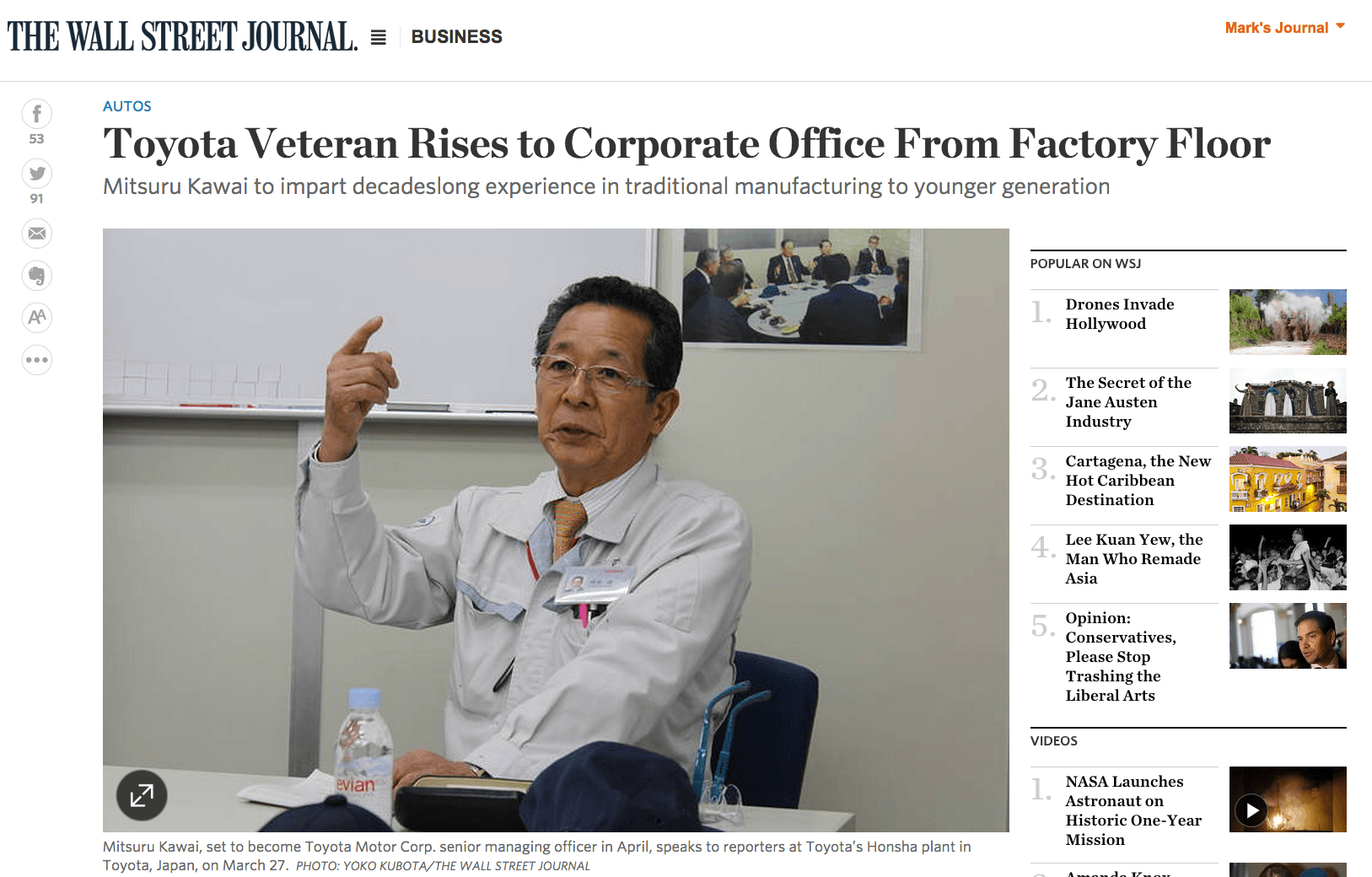I hope you might have access to this interesting article from the Wall St. Journal: “Toyota Veteran Rises to Corporate Office From Factory Floor.” I was able to access it while logged out from my WSJ account.
Mitsuru Kawai, pictured, started working at Toyota in 1963, at age 15. After 52 years of employment, Kawai is going to be in the position of senior managing officer, “the highest position ever held by a blue-collar worker in Toyota's eight decades,” per the WSJ.

Part of his new job:
“Mr. Kawai's main task will be overseeing Toyota's plants, positioned to utilize his experience in traditional manufacturing and the Toyota Production System, the term for the lean-manufacturing methods and philosophies that the company has developed over decades… The production system has been adopted by a wide range of companies beyond the auto sector, including hospitals and plane manufacturer Boeing Co.”
The WSJ sort of has this backward… “Lean Manufacturing” is the broader term for the methods and philosophies developed by Toyota. Their sentence sort of reads like Toyota created their own name for Lean. But, the WSJ often shows very little understanding for Lean and TPS.
So what else is interesting about his story?
When he joined Toyota, they made 300,000 cars a year, now they make 10 million.
“Kawai is one of the few people remaining at Toyota who had the chance to witness in person the works of Taiichi Ohno” (one of the creators of TPS). That's an interesting connection to Toyota's history.
Kawai has seen their production processes evolve from cars being primarily built by hand to the modern era where robots and automation have a bigger role. Kawai “became concerned” that modern factory employees have lost some basic skills, so installed “workshops within factories that take workers decades back in manufacturing technologies,” that includes parts of the plant where some assembly is being done by hand (a modern marketer in the U.S. would hype this as “hand crafted”).
That area is 50% less efficient than it would be with more automation.
Hear Mark Graban read this post (learn more and subscribe):
But, Kawai has an interesting, long-term, perspective in that “what appears inefficient is actually a necessity for Toyota to continue growing.”
People often mistakenly think that a Lean auto factory is more automated and full of robotics. TV ads from GM and Chrysler usually glorify robots instead of people, so it creates an impression that people don't play much of a role (which helps feed the cries against “assembly line medicine” because people think assembly lines are only full of robots).
Toyota plants tend to be LESS automated than other automakers. Why? Kawai explains it well:
“Automation took place by numerating and standardizing a human's manual skills,” he said. “But robots can't teach robots how to do things in a better way. You need the human wisdom to make improvements.”
Doing things in a better way… making improvements. That's Kaizen!
I always bring this point up when hospitals want to automate tasks, such as pushing carts around the hospital to restock supplies and medications. A robot cart can't smile and say hi to a visitor and they can't participate in continuous improvement efforts, which is, of course, a major part of a Lean methodology and culture.
Congratulations to Mr. Kawai. It's pretty unheard of for somebody to move up the ranks like that in one of the Detroit automakers. At best, people like GM CEO Mary Barra, are noteworthy because their father was an hourly worker. I've seen some hospitals where a front line nurse has moved up to be COO… I'm not sure how often they work their way up to be CEO unless they are a physician, have an MHA degree, or have a finance background.
What do you think? Please scroll down (or click) to post a comment. Or please share the post with your thoughts on LinkedIn – and follow me or connect with me there.
Did you like this post? Make sure you don't miss a post or podcast — Subscribe to get notified about posts via email daily or weekly.
Check out my latest book, The Mistakes That Make Us: Cultivating a Culture of Learning and Innovation:










Mark,
Thanks for paying respect to Mitsuru-san by sharing his wisdom & methods in practicing hansei (deep reflection).
This is Toyota setting a good example of respect for people for valuing a resource for their ability to contribute added value to the customer (or organization) with experience, perception and capability – not just executive potential based on educational pedigree or political prowess.
This is also commitment to the the first principle – Base Your Decisions on a Long-Term Philosophy …
The thought process that drives some companies to misplaced value of certain resources may be a focus on short-term risks. Your thoughts?
Yes, short-term thinking is a huge problem in Western organizations (and this includes healthcare).
Dr. Deming made a big deal about long-term thinking.
Point 1 of “The Toyota Way” is about long-term thinking.
But, more people are “implementing Lean” by trying to copy 5S or do a few Kaizen Events instead of focusing on long-term thinking, which holds everybody back.
A short but powerful audio blog that clearly articulates the value of growing talent (the fourth circle) from within. Interesting enough, my sensei’s Kato (80) & Harada (74) always stressed these exact points especially because you already invested in sharing the principles and practices of TPS, TPM & TQM (the other three circles). Keep igniting the talent of others!